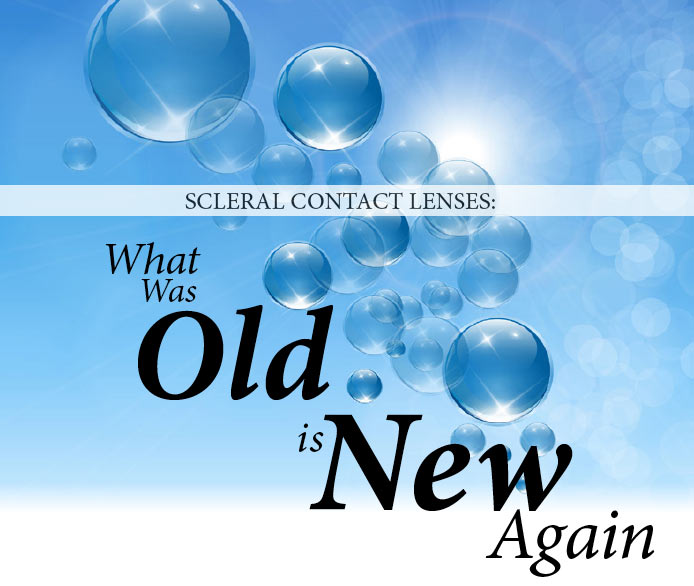By Shirley Ha, HBSc., O.D.
Since they debuted as glass-blown “shells” in 1887, scleral lenses have been in and out of favour. Most recently, they have made a comeback on the contact lens scene. The success of the vault-fitting principle in rehabilitating and correcting distorted and compromised anterior surfaces is undeniable but the expanded scope of use for scleral lenses to include normal eyes is fairly recent. Today, virtually every contact lens patient is a prospective scleral lens candidate, thanks to technological advances in lens designs, higher Dk materials, better manufacturing processes and unprecedented customization.
In general, sclerals are large-diameter rigid gas permeable lenses. The Scleral Lens Education Society (www.sclerallens.org) divides the lens into three categories based on size and bearing zone: Corneal (8.0-12.5 mm), Corneoscleral (12.5-15.0 mm) and Full Scleral (15.0-25.0 mm). They can be made in a range of shapes to suit any corneal profile, from very flat corneas to complex topographies.
The basic fitting philosophy and counseling for sclerals have not changed. They are not as intimidating to fit or any more time consuming than other specialty fits. However, having diagnostic trial scleral fitting sets with different base curves, diameters and peripheral curves is crucial. Depending on the lens designs, many are available on loan from the laboratory for trial fitting purposes.
In its simplest form, there are three parts to a scleral lens: the rise, the run and the diameter. The rise is the apical radius of curvature of the lens and depends on the most important metric, the sagittal height (SAG) or the anterior chamber depth of the eye. The run is the peripheral curve or how steep (oblate) or flat (prolate) the periphery is, relative to the base curve. The diameter is directly related to the SAG and can be increased or decreased to elevate the lens off the eye or lower the lens closer to the eye.
For the best fitting relationship, the central base curve of the scleral lens must completely vault over the cornea with good clearance over the limbus to protect the area from inflammation, in-growth and neovascularization. The peripheral curves should land uniformly or parallel to the scleral profile and not have uncomfortable edge lift or conjunctival vessel impingement.
The lens should move minimally, if at all. The apical tear clearance should be adequately exchanged via capillary attraction and not exceed 200 µm for a maximum 250 µm centre thickness lens. There should not be any lens flexure that can cause conjunctival blanching from the negative pressure effect produced in blinking. If fitted properly, scleral lenses are as comfortable as soft toric lenses. If there is initial discomfort, one or more of the lens parameters should be changed.
The purpose of the pre-corneal tear reservoir or chamber is two-fold: it takes the corneal refractive power out of the picture and enhances vision by creating a new spherical refracting plane, and it supports and protects the corneal physiology and surface integrity.
Due to the minimum lens translation, scleral lenses are the ideal choice for healthy eyes with high irregular astigmatism, especially prescriptions that are outside the available parameters or cannot be fitted properly with standard RGPs. Any over-refracted astigmatism not caused by flexure can be surfaced with front, back or quadrant-specific toricity in the optic zone of the lens. If warranted, a toric flange can be ordered for scleral toricity to better align the peripheral curves onto the sclera.
For oblate corneas with steeper peripheral curves than central curves, as in post-refractive laser surgery patients, reverse geometry corneoscleral lenses work well in correcting the modified corneal surface while alleviating the often comorbid dry eyes.
For presbyopes who drop out because their current contact lenses are no longer effective at near, multifocal scleral lens options are now available. Because the lenses are immobile, most laboratories use simultaneous image designs with near centre optics.
For the novice scleral lens fitter, A Guide to Scleral Lens Fitting by Eef van der Worp is a great place to start. Online communities such as the GP Lens Institution and the Scleral Lens Education Society provide forums, educational webinars, instructional tutorials, workshops and curricula to help professionals learn more about this specialty lens modality, including fitting guides for the different proprietary lens designs and materials, lens handling and care products. Through these online communities, scleral lens experts around the world review clinical cases and help troubleshoot fitting or complication challenges, such as decentrations, air bubbles, surface/reservoir deposits, non-wetting and corneal hypoxia.
Additionally, don’t forget to work with the clinical consultants at laboratories – they have a wealth of information about scleral lenses and are more than happy to impart their knowledge and experience to you. It is a journey that both you and your patients will find rewarding.








